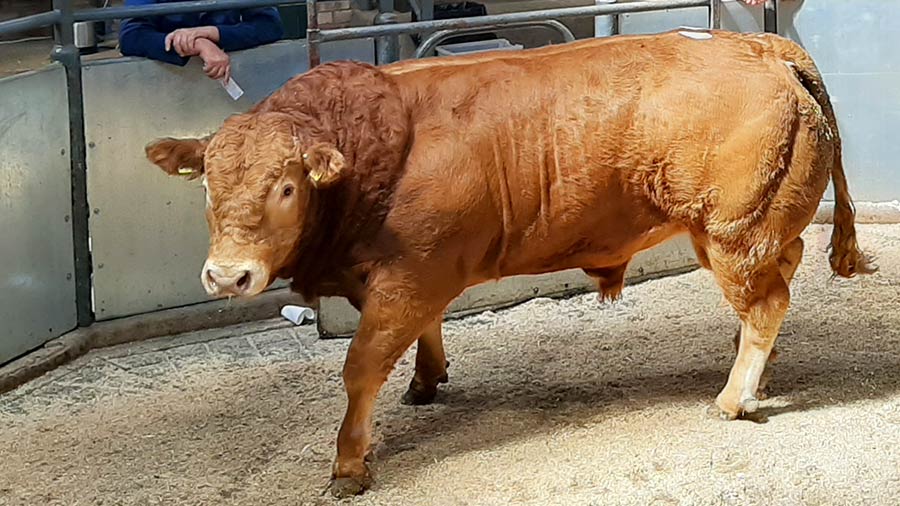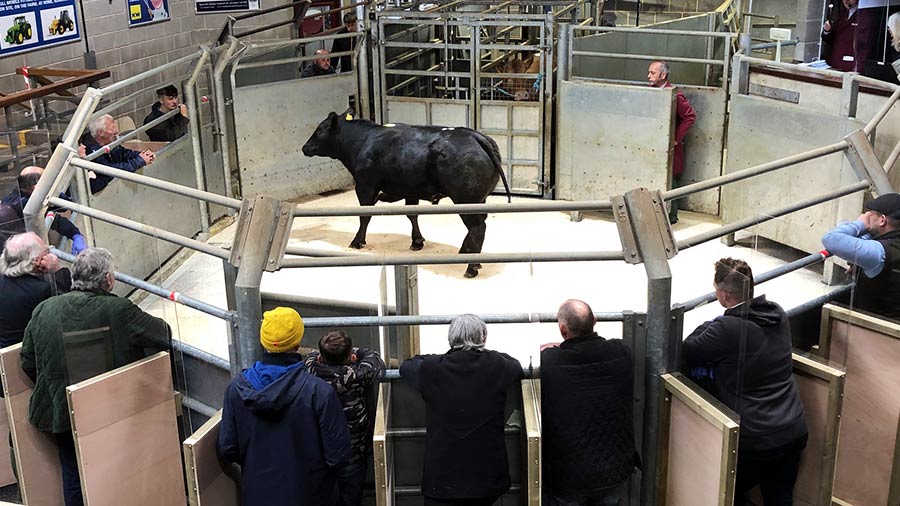What have livestock markets learned from 2020?
 Knaggs bull at Northallerton © Livestock Auctioneers Association
Knaggs bull at Northallerton © Livestock Auctioneers Association Livestock markets will enter 2021 with cautious optimism following a vintage year.
Higher throughputs and prices for prime cattle and lambs, milkers and breeding sheep proved the resilience of the liveweight system.
The sector’s innovation and adaptiveness were demonstrated as markets adjusted to rising butcher and wholesaler demand, and worked within evolving hygiene and social distancing rules.
At a time when Britain’s farmers came to the fore, the markets rallied to help them feed the country, Farmers Weekly reflects on a remarkable year and what the mart sector has learned.
See also: Taking Stock looks back on 50 years of farming
January/February
- Prime cattle prices start the year below the five-year average. Deadweight cattle are 20p/kg behind the five-year average in the new year at 330p/kg
- Farmers with hoggs to sell have the highest new-year prices in memory in January. Hogg SQQs reach 244p/kg in February. Lower pig production in China and less New Zealand product support strong UK prices
March/April
- Covid-19 hits and children, the over 70s and social visitors are asked not to come to marts. Market canteens are asked to switch to takeaway services
- Cull ewes break all records in the week ending 21 March. A mixture of panic and speculative buying lift the GB average to £112 as buyers pre-empt market closures due to Covid
- The sheep sector gets a taste of what losing European exports might be like on the morning of Monday 23 March. Lambs lose 70p/kg and thousands are sent home amid market chaos. Lamb exporters close as demand from European consumers evaporates overnight and major food halls and markets shut. Many markets sell 10% of a typical seasonal entry
- Breeding sales are discontinued for one month from 25 March. A “drop and go” policy is implemented for prime and store sales
- In response to social distancing and the lockdown, breeding and dispersal sales start to take place online. Harrison & Hetherington holds its first fully online dairy bull sale on 14 April
- Dairy auctioneers are forced to travel great distances to sell dairy cattle in the absence of breeding sales. With no sale competitive bidding, milkers lose about £150 a head
- Ewes with lambs at foot see some price resistance without a competitive ring as buyers stick to budgets
- Breeding sales recommence on 27 April and the “drop and go” policy is replaced with the 2m rule

Buyer booths at Skipton © Craven Cattle Marts
May/June
- Dairy milker prices lift, following the return of weekly collective sales and the Bounce Back Loan Scheme announcement in late April
- Markets increasingly start to use websites and social media to disseminate more information about key sale dates and livestock on offer
- Planes remain grounded and holidaymakers stay at home to the benefit of UK meat retailers
- Prime beef and lamb prices remain high. Scottish butchers see a retail spike of 20%
July/August
- Commercial fresh dairy heifers hit their highest price of £1,694 a head in the first week of July as competitive bidding and the Bounce Back Loan Scheme fuel demand
- Lamb prices start a four-month period of tracking 25-40p/kg up on the year, as wholesalers and butchers see strong sales and the economy opens back up again. The liveweight SQQ only drops below 220p/kg three times from July to November
- Marts are requested to advise buyers and vendors to wear face coverings on 20 August
- Prime heifer prices average 215-220p/kg at markets during the summer, as butcher orders double and the Eat Out to Help Out scheme bolsters wholesaler demand
September/October
- Breeders send in videos of livestock to help market stock
- Breeding sheep sales see averages of £20-£30 up on the year, reflecting strong lamb prices
- Flagship sales like the Kelso and Builth Wells tup sales are rearranged and smaller breed-specific sales organised
November/December
- Pedigree bull sales and Christmas prime stock shows take place but with heavy restrictions on visitors
- “Drop and go” policy returns at livestock markets for the second lockdown on 5 November
- Lamb SQQ starts increasing in November beyond 200p/kg as Christmas orders and tighter supplies support the price
Six lessons from 2020
1. Live markets are adaptive and resilient
Marts have responded to processor closures, changing hygiene rules and new social distancing guidelines, ensuring a competitive bidding process online or ringside.
Even with major question marks over how diminishing subsidy and Brexit will impact on farming businesses and livestock markets, the past year bodes well for the sector, showing it can work through peaks and troughs in demand.
2. Online selling is the future
Social distancing has “pushed at an open door”, in terms of online sales. Several markets were looking into virtual streaming and online bids pre-Covid, and this was already a regular fixture at some pedigree sales and dairy dispersals.
Farmers have been spared huge journeys for elite breeding stock, and as farmers get increasingly “time poor”, this could help markets stay relevant in the future.
3. Diversified income is essential for some businesses
The extreme volatility seen this year shows that livestock trading is an essential service provided by markets that impact on food security. In other years, commission from livestock sales may have looked the poor relation compared with consultancy and property valuations.
Whether a market is a larger, more modern agri-business centre housing other services and businesses or a smaller, older site, multiple income streams will help the market survive. Livestock prices will be pressured in the future and a robust business structure is essential.
4. Markets are needed, big or small
Seasonal sales of calves, store lambs and breeding sheep in more remote areas of Britain were hugely successful this year. Crofters and hill farmers generated income, injecting cash into fragile rural economies.
A strong year for sales will hopefully enable some smaller and older markets to reinvest in infrastructure. Government demands on welfare, safety and environmental standards will not let up.
5. Communication is key
While markets compete on a local or specialised breeding level, 2020 has unified the industry.
Markets and auctioneers discussed dates to avoid fixtures clashing. They also shared venues to ensure social distancing and adequate buyer presence after the cancellation of flagship ram sales.
Similarly, prior to Covid-19, the Livestock Auctioners’ Association’s Next Generation Group had started bringing young auctioneers together for informative trips out to swap ideas and debate issues. A similar initiative had been started by the Institute of Auctioneers and Appraisers in Scotland.
Selling livestock in a competitive public environment and paying vendors on the day has inherent challenges, such as disruption from anti-farming extremists and exposure to unreliable buyers and bad debt, which remains a very difficult issue.
Strong lines of communication will strengthen the sector by sharing valuable information and best practice to improve markets and help them thrive.
6. Social element is hugely valuable
Shows and key farming events have been cancelled or moved online and face-to-face interaction has been reduced.
Some markets have mental health charity workers, chaplains, health drop-in centres and host sessions for the National Federation of Young Farmers’ Club and other local events.
This type of work will remain a key additional benefit over and above the core role of marketing for rural businesses. Many people missed this valuable interaction this year and will hope normality resumes.
